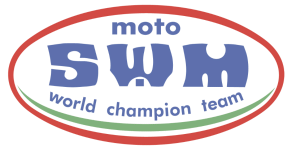

Speedy Working Motors, known as SWM, was formed by Piero Sironi and Fausto Vergani on 11 July 1971.
At that year's Milan Show they presented a regular model equipped with a six-speed Sachs engine. The production of enduro motorcycles began a year later at the factory in Rivolta d'Adda and models with engines of 50, 100 and 125cc were proposed. The new company is immediately in the limelight, having won the Italian 125cc motocross championship with Rustignoli riding, while Rottigni took third place in the 125 European Enduro Championship class and won three medals at the Six Day in Czechoslovakia.
1973 consolidated their presence on the track, and Perego won the 50cc class in the Italian enduro championship. Their commitment to the sport has a positive effect on production that offers the Regularity versions, ie ER (Revolt Processing) and ES (Development Sachs) in displacements of 50, 100 and 125 cc. 1975 brought success with the Silver Vase at the Isle of Man Six Days, along with three Italian championships. Production was expanded to include 175cc models.
That year's production totaled about 10,000 units. In 1976 the now famous off-road motorcycles were joined by mopeds, scooters and children's bikes, using Minarelli engines. In 1977 Rotax engines were introduced after a disaster with the new seven-speed Sachs engines. The rotary disc valve Austrian engines were fitted to most models, and bear the model codes RS-GS for the enduro and MC for the motocross models.
At the Milan salon SWM presented their first observed trials motorcycles. Another year of good sports results and good sales followed, and in 1979 when full range of motorcycles is renewed and offered with new identification codes: TF1 for enduro motorcycles and TF2 for the cross.
Production commenced of the 350cc Trial GTS 315. The trials machines become important and in 1981 SWM 320 TLNW won the world title with Gilles Bourgat at the helm.
In the same year SWM team of three riders wins the Six Days, while the cross is presented new technical solutions such as rear suspension called PLB System. The commercial failure of the SWM 124 RZ street bike was a setback and it was thought that perhaps it had not been understood by the public. In 1982 begins the slow descent of the Lombard brand. In the trial SWM comes second in the world with the American Bernie Schreiber while Galeazzi won the Italian championship.
Nothing good in the enduro. In mass production comes the XN 350 and 500, single-cylinder four-stroke enduro. They entered an agreement with Tau for the supply of two-stroke engines. To seek redemption in the enduro, in 1983 the motorcycles of the RS-GS S1 series but now the motorcycle market and off-road in decline and in 1984 economic difficulties force SWM to close the racing department, and then also the manufacturing plant.
Scuza Itanglish
Source: Moto di Lombardia
If you have a query about these vintage Italian machines, please contact us